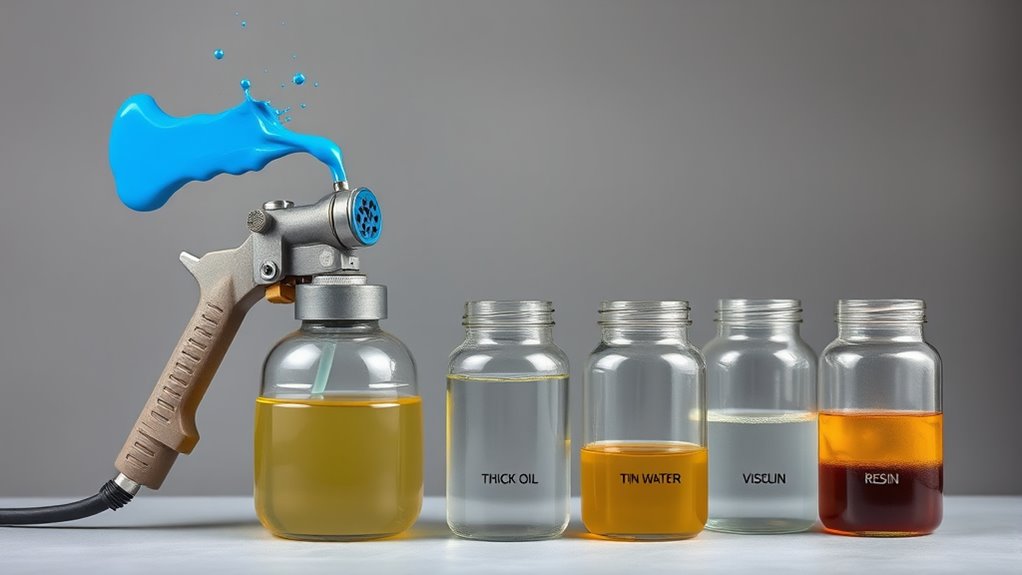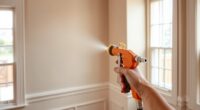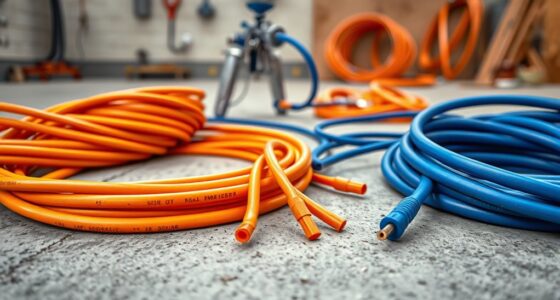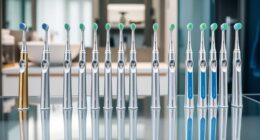You can use compatible liquids like thinned paints, stains, or sealers in a paint sprayer, but you should avoid incompatible substances such as thinners like mineral spirits, acetone, or thick adhesives that can clog or damage your equipment. Always check if the liquid is suitable for spraying and follow proper dilution guidelines. Using the wrong liquids can cause clogs or health hazards. To discover more about safe and effective options, keep exploring further details.
Key Takeaways
- Suitable liquids include diluted paints, stains, and sealers with proper viscosity; avoid thick or incompatible substances.
- Never use flammable or chemical solvents like mineral spirits or acetone, as they can damage equipment and pose safety risks.
- Caulks, adhesives, and thick oils are unsuitable due to clogging nozzles and inability to atomize properly.
- Always follow manufacturer guidelines for dilution and test spray before full application to ensure proper results.
- Proper cleaning and safety precautions are essential to prevent hazards and maintain spray gun performance.

While paint sprayers are versatile tools that can substantially speed up your project, not all liquids are suitable for use with them. Before you start experimenting with different substances, it’s essential to understand how DIY spray techniques work and the safety precautions you need to take. Using the wrong liquids can damage your sprayer, create health hazards, or produce unwanted results.
Not all liquids are safe for spray guns; using the wrong ones can cause damage or hazards.
When considering what liquids to spray, always check the manufacturer’s guidelines. Many sprayers are designed specifically for paints, stains, or sealers, which have the right viscosity and consistency. Thinning thicker liquids will often be necessary to achieve a smooth spray pattern, but you should be cautious not to over-thin, as this can affect the finish or clog the nozzle. Remember, your goal with DIY spray techniques is to produce an even coat with minimal runs or drips, so adjusting the liquid’s viscosity properly is key.
Some liquids, like clear wood finishes or certain sealants, are generally safe to use in a spray gun if they’re properly diluted. These can give you a professional-looking finish without the hassle of brushes or rollers. However, you must always wear protective gear—such as masks, gloves, and goggles—and ensure your workspace is well-ventilated. Safety precautions are non-negotiable, especially when working with chemicals that could emit fumes or particles harmful to your lungs or skin.
On the other hand, many liquids should never go through your sprayer. Thinners like mineral spirits or acetone are highly flammable and can damage the internal components of your equipment. Similarly, caulks, adhesives, or thick oils are not suitable because they clog nozzles and aren’t designed to be atomized. Using these substances can cause equipment failure or create health risks from inhaling fumes or exposure to skin.
To stay safe and get the best results, do your research before trying new liquids. Always dilute as recommended, perform a test spray on scrap material, and clean your equipment thoroughly afterward. If you’re unsure whether a liquid can be sprayed, consult the product label or manufacturer instructions. Remember, safety precautions aren’t just about avoiding accidents—they’re about ensuring the quality of your project. Proper color accuracy and viscosity adjustments are essential for achieving professional-looking results with your spray gun. When you follow proper DIY spray techniques and respect safety guidelines, you’ll find that your spray projects are not only faster but also safer and more professional-looking.
Frequently Asked Questions
Can I Use Household Cleaners in My Paint Sprayer?
You shouldn’t use household cleaners in your paint sprayer because they can damage the equipment and pose safety risks. Instead, look for household cleaner alternatives like specialized cleaning solutions designed for sprayers. Always follow sprayer safety tips, such as thoroughly rinsing after use and avoiding harsh chemicals. This guarantees your sprayer stays in good condition and your projects remain safe and effective.
Are There Eco-Friendly Liquids Compatible With Paint Sprayers?
You’re wondering if eco-friendly liquids work with paint sprayers. The good news is, eco-friendly solvents and biodegradable thinners are compatible, helping you minimize environmental impact. Just make sure to check the manufacturer’s guidelines for your specific sprayer, as some eco-friendly options may require adjustments in viscosity or mixing. Using these liquids allows you to achieve great results while staying eco-conscious and reducing harmful emissions.
What Liquids Should I Avoid to Prevent Damage?
You should avoid liquids that can cause chemical reactions or contain corrosive substances, as they can damage your paint sprayer. Stay away from acids, strong solvents, or industrial cleaners, since these may corrode internal parts or clog nozzles. Using incompatible liquids risks damaging the equipment and creating safety hazards. Always check manufacturer recommendations before trying new liquids, ensuring they’re safe and compatible with your sprayer.
Can I Thin Thicker Paints With Water or Solvents?
You can thin thicker paints with water or appropriate solvents to improve paint consistency. Use water for latex or water-based paints, making sure you add gradually to avoid over-thinning. For oil-based paints, select compatible solvents like mineral spirits or paint thinners. Always check the paint’s label for solvent compatibility, and test the mixture before spraying to prevent clogging or damage to your sprayer. Proper thinning ensures smooth application and prevents equipment issues.
How Do I Clean My Sprayer After Using Non-Paint Liquids?
When you finish using non-paint liquids in your sprayer, start by rinsing it with water or the appropriate solvent. Use brush cleaning to remove residual material, ensuring no clogs form. Choose your solvent carefully based on the liquid you used—water for water-based, or a compatible solvent for oil-based substances. Thorough cleaning prevents damage and keeps your sprayer in good shape for future projects.
Conclusion
While it might seem tempting to experiment with various liquids in your paint sprayer, not all are safe or effective. Some, like water-based solutions, work well, but others, such as thick oils or unknown chemicals, can damage your equipment or produce poor results. *Notably*, a common myth suggests you can use household cleaning agents in a sprayer, but this often leads to clogging or corrosion. Stick to recommended liquids for the best, safest outcomes.
Franz came aboard the Paint Sprayer Zone team with a background in both journalism and home renovation. His articulate writing style, combined with a passion for DIY projects, makes him an invaluable asset. Franz has a knack for breaking down technical jargon into easy-to-understand content, ensuring that even the most novice of readers can grasp the complexities of paint sprayers.










